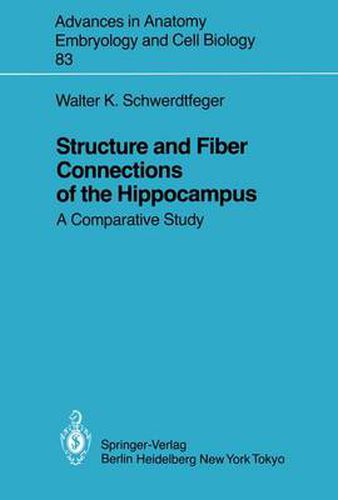Structure and Fiber Connections of the Hippocampus: A Comparative Study
Walter K. Schwerdtfeger

Structure and Fiber Connections of the Hippocampus: A Comparative Study
Walter K. Schwerdtfeger
This title is printed to order. This book may have been self-published. If so, we cannot guarantee the quality of the content. In the main most books will have gone through the editing process however some may not. We therefore suggest that you be aware of this before ordering this book. If in doubt check either the author or publisher’s details as we are unable to accept any returns unless they are faulty. Please contact us if you have any questions.
Of all cytoarchitectonic structures in the brain of mammals, the hippocampus is perhaps the most conspicuous because of its unusual macroscopic and micro- scopic appearance. During phylogeny, the hippocampus has developed from a single cortical plate in amphibia into a complicated, three-dimensional convo- luted structure in mammals. Because of its clear lamination into axonal, perikaryal, and dendritic layers, the hippocampus has often been considered a simple cortex model. Indeed, this trilaminated construction resembles perhaps the least complicated type of neuronal cortex. There is a large literature describing hippocampal morphology in many species with respect to cytoarchitectonics, fiberarchitectonics, angioar- chitectonics, chemoarchitectonics, synaptology, and fine structure. On the other hand, up to the present day there has been no generally accepted concept on the main functions of the hippocampus, although many studies dealing with its physiological and biochemical properties and its possible influences on behav- ior have provided some valuable indications. Early investigators described the hippocampus as being a part of the rhinen- cephalon (e. g. Zuckerkandl 1887), together with other allocortical structures, such as the olfactory bulb, olfactory tubercle, and piriform lobe. Thus, the hippocampus was assigned to the olfactory system, and it was not until improved degeneration techniques were applied that this error could be corrected. It be- came clear that only part of the allocortical areas receive direct olfactory inputs, namely the retrobulbar region (anterior olfactory nucleus), precommissural hip- pocampus, olfactory tubercle, prepiriform region, periamygdalar region, and part of the entorhinal region.
This item is not currently in-stock. It can be ordered online and is expected to ship in 7-14 days
Our stock data is updated periodically, and availability may change throughout the day for in-demand items. Please call the relevant shop for the most current stock information. Prices are subject to change without notice.
Sign in or become a Readings Member to add this title to a wishlist.


